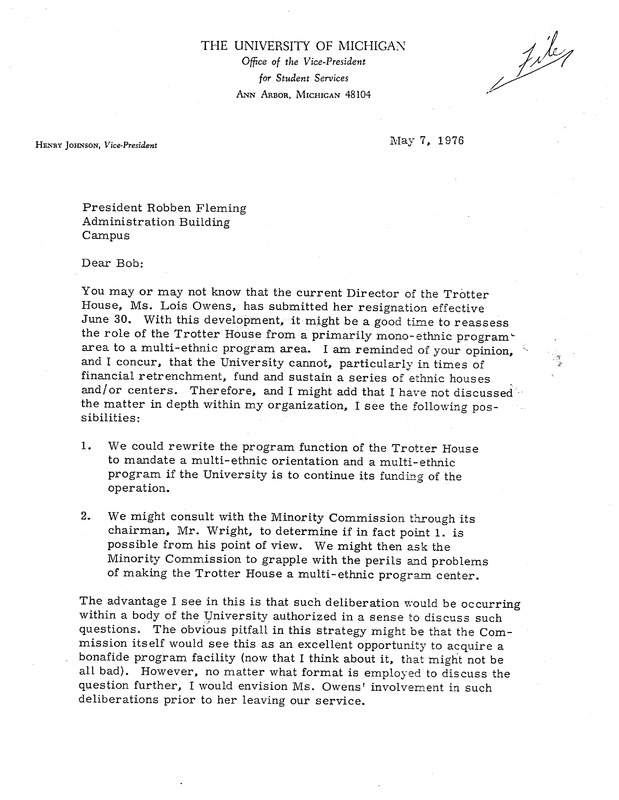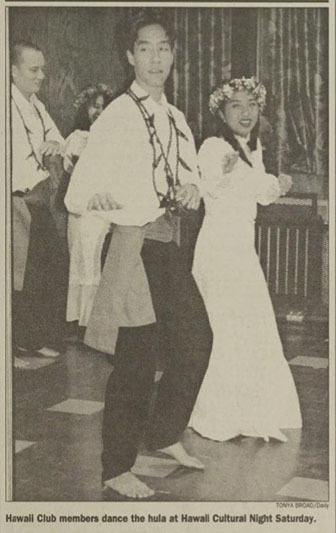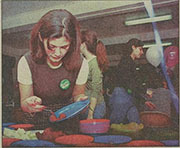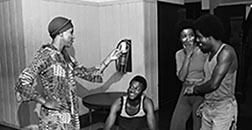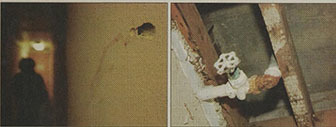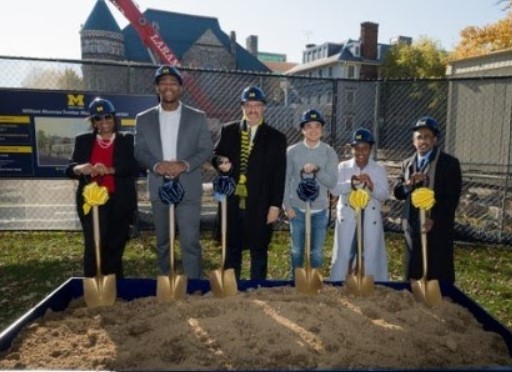William Monroe Trotter Multicultural Center
The demand of the Black Action Movements that was always present, across the years, was the construction of a Black Culture Center and/or improvement of the building housing the center. The BAMs pushed the university to first remodel Trotter and finally build a new center on Central Campus.
As stated above, the Trotter Multicultural Center, as it is known today, began as Trotter House, a Black Student Cultural Center. While the Trotter Center started as a Black student cultural center, in 1981, the center expanded its focus to a Multicultural Center.
The 1976 memo above from Henry Johnson, Vice President of Student Services, details financial concerns about having multiple “monoethnic” programs rather than having one multicultural center. This is not the first time University of Michigan administrators had voiced issues with having several ethnic/cultural centers on campus. In April 1, 1970, for instance, the University of Michigan Regents released a statement that clearly demonstrated that the University of Michigan did not want several ethnic centers on campus:
“The Regents are opposed to the establishment of University financed
special student centers on the basis of race, religion or ethnic considerations.
If there are to be centers the Regents believe they must be justified on other grounds.”
Although the center was called the Black Cultural Center, no one was turned away from programs because of race, religion or ethnic considerations. Five years later, and six years after the creation of Trotter House, the name changed to Trotter Center and its mission changed to that of a multicultural center.
Multicultural Programs at Trotter House
Despite being the Black cultural center, Trotter House hosted many multicultural events over the years, including both celebrations of Hawaiian and Puerto Rican culture.
Dancing the hula, students in the image above take part in “Hawaii Cultural Night '' hosted at the Trotter Center to share the food and music of Hawaii. The event included a multi-course feast and a cultural show for the 120 guests.
In the picture above, LSA sophomore Ana Rogriguez, one of the organizers of “A Taste of Puerto Rico,” serves dessert for over 50 participants as part of “Puerto Rico Week.” The week-long celebration included a viewing of a Puerto Rican film, dance, and musical performances. These celebrations allowed for students to share their cultures with the wider University of Michigan community.
Trotter Center Directors
The Trotter Center has had many directors since its doors opened in 1971:
- Alex Hawkins
(1971–1972) - Thaddeus R. “”TR” Harrison
(1972–1973) - Lois Owens
(1973–1976) - Beulah Sanders
(1976–1979) - Reginald “Reggie” Armstrong
(1979–1980) - Jemadari Kamara
(1980–1981) - John Powell
(1981–1983) - Michael L. Swanigan
(1984–1994 & 2017–2018) - Edward “Ed” Burnett
(1994–2014) - Jacqueline D “Jackie” Simpson
(2014–2017) - Julio Jose Cardona
(2018–2020)
At the present time in 2022, Trotter Center is without a director. With the resignation of Julio Cardona in January 2021, Kellyn Mackerl-Cooper, Trotter Associate Director and Nadia M. Bazzy, MESA Director, provide internal and divisional support to Trotter through the director vacancy. Entering 2020 the pair continues to provide leadership as a search for the director is being initiated.
All of the directors have contributed to the Trotter Center and left behind legacies, endeavoring to create a welcoming atmosphere. Two such legacies are described below. Thaddeus R. (TR) Harrison was announced as the youngest Director of Trotter House at 20-years-old, according to an article in the September 19, 1972 edition of the Ann Arbor News. Harrison was a protester during BAM I and was among a group of Black students arrested for hitting an Ann Arbor police officer with a brick. Charged with assault with intent to commit great bodily harm, Harrison faced 10 years in prison. He was found guilty of felonious assault, a lesser charge, but still a felony that could have ended his dream of becoming a lawyer. While appealing the conviction, Harrison finished his degree in May 1972 at the University of Michigan in two and a half years, and became the director of Trotter in September of 1972. The felony conviction was reversed in 1973 by the Michigan Court of Appeals.
Harrison, pictured above in 1990, in front of the “The Cube” in Regents Plaza on the University of Michigan-Ann Arbor campus, made it his mission as director to make Trotter House a home away from home. Harrison would go on to receive his law degree from the U-M Law School in five years.
Lois Owens served as Trotter House director from 1973 to 1976. As part of her tenure, Owens started an African dance group and a gospel choir in 1973 in order to include more cultural heritage celebrations. Owens was closely involved in the dance group and the choir.
Pictured above, Lois Owens prepares the Trotter House dance troupe for her farewell concert. It had seven members: Donald Preshy, Cecile Keith, Thom McClain, Maria Mitchell, Mildred Morton, and Bernard Wiseman.
Facilities Issues
Over the years, the Trotter Center was in need of serious repairs. In 2004, students were rallying for renovation to Trotter in the wake of Office of Multi-Ethnic Student Affairs (MESA) funding cuts. An article in the Michigan Daily, “Student Trotter House Badly in Need of U-funded Repairs,” published shocking photographs of the state of Trotter Center.
In the photographs published above, the image on the left shows a gaping hole in the wall while a student walks by, and in the image on the right, an exposed pipe in the bathroom shows severe rust and decay. In 2005, Trotter facilities manager Edward Burnett was quoted in an article in the Michigan Daily by Carissa Miller saying, “I’ve been here for eleven years and there was definite need for renovations.” The university allocated $800,000 for renovations and an additional $200,000 for immediate repairs.
However, students from many campus organizations, including La Voz Latina and the South Asian Network, cited the condition of the building as evidence of the university’s lack of commitment to diversity.
New Trotter on State Street
In 2017, 13 years after the Trotter Center was in need of immediate repairs, the University of Michigan broke ground on a new building.
In the image above, President Schissel celebrated the groundbreaking, with gold shovels, alongside student, faculty, and staff representatives, including Michael Swanigen (on the right), the former interim director of the Trotter Center. Less than two years later, the new center opened in its new location on State Street — with the doors open on April 8 and a grand opening celebration on April 11.
The celebration of the opening, pictured above, featured students, staff, and faculty celebrating with banners and flowers. In the Michigan Daily article, “After decades of activism, new Trotter Multicultural Center opens on State Street,” President Schlissel stated that, “the Trotter Multicultural Center is a new home for many personal and shared identities, for unity, for learning, for reflection and for hope.” The new 10-million-dollar Trotter Multicultural Center is a result of decades of activism by students starting in 1969. Five years after Hashtag #BBUM, the new Trotter Multicultural Center opened on April 8, 2019.

The Black Action Movements (B.A.M.)

About the Exhibit

